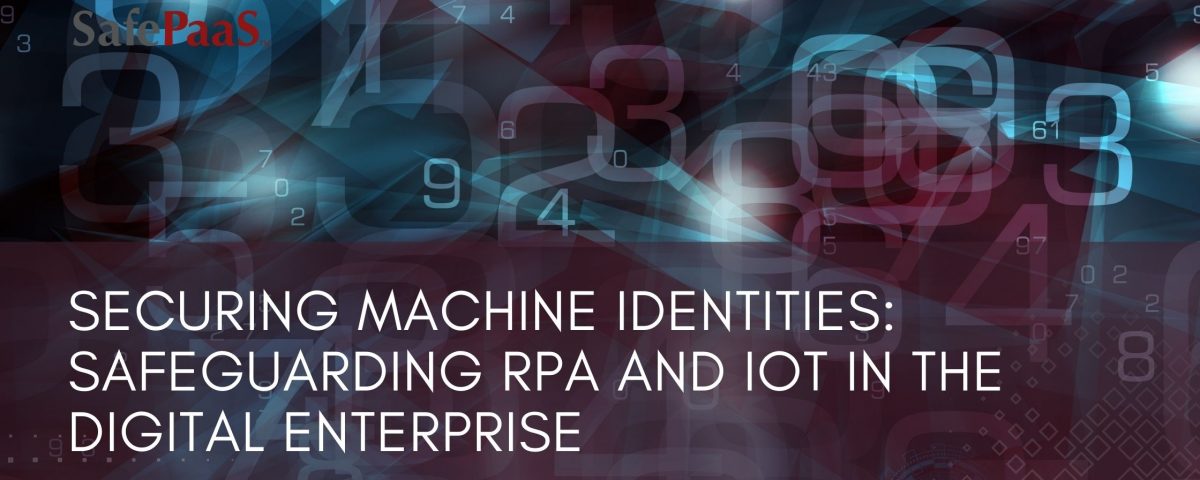Securing Machine Identities: RPA and IOT


Securing Machine Identities: Safeguarding RPA and IOT in the digital enterprise
More organizations are digitally transforming by embracing cloud and digital technologies and processes to bring new products and services to market faster. Digital transformation simultaneously reduces costs and complexities and provides greater flexibility and accessibility.
However, managing risk and security has become increasingly difficult in the digital age. In the past, efforts to mitigate risks and protect data primarily centered around safeguarding individual users and their actions. And with the widespread adoption of the Internet of Things (IoT) and Industrial IoT (IIoT), it is now imperative your organization prioritizes the security of machine identities and their actions. In other words, your organization must ensure your user's safety and actively discover, monitor, and protect your workloads, data, bots, and connected devices.
Security risks of machine identities
It is estimated that by 2025 there will be over 30 billion machine identities, and organizations that underestimate the risk introduced by unsecured machine identities leave themselves extremely vulnerable. Insufficient security measures for connected devices and their data create an easy target for bad actors, enabling them to identify numerous vulnerabilities and launch attacks. This includes stealing intellectual property, conducting industrial espionage, or even sabotaging product manufacturing. The absence of secure connections for connected devices poses a particularly alarming threat in regulated industries like healthcare or energy, where a compromised heart monitor or power grid can result in loss of life.
These risks are not mere conjectures but have manifested in real-world incidents. For instance, in 2021, a hacker breached a water treatment facility in Florida, exploiting their access to manipulate connected devices and dangerously increasing sodium hydroxide levels in the water. Similar threats have been witnessed over the years, with oil pipelines being hacked and nuclear programs being attacked.
Insufficient security measures for machine identities can also adversely impact your organization's operational efficiency, agility, and long-term sustainability. If new technologies and connected devices cannot be swiftly and securely integrated or mission-critical applications and data cannot be migrated to the cloud confidently, your organization risks losing ground to competitors. Moreover, your financial performance could suffer, accompanied by compliance penalties, ransomware incidents, reputational damage, and a loss of customer trust.
How machine identities hinder security advancement
The volume of machine identities and their behaviors significantly challenges advancing security efforts. One major obstacle lies in the overwhelming number of machines that require protection. With the continuous growth of the IoT and IIOT, the quantity of connected devices has already surpassed the number of device users. Addressing the scale of identities requires the implementation of robust identity governance and the establishment of more secure ecosystems in various industries.
Furthermore, the very nature of machine identities poses another significant security hurdle. Machine identities, such as application programming interfaces (APIs) and robotic process automation (RPAs), often handle background tasks such as facilitating connections between services in an organization's cloud environment or managing repetitive administrative duties. Essentially functioning as digital users, APIs, and RPAs frequently interact with sensitive company assets and personally identifiable information. These machine identities typically lack proper governance and are often unknowingly granted privileged access, which creates enticing cybersecurity vulnerabilities that malicious actors can exploit.
How to manage machine identities securely and efficiently
Making machine identities a priority and treating them as privileged users is crucial for organizations to address digital transformation's risks and security challenges effectively. This entails ensuring that each machine's identity and connected device has appropriate access to the necessary resources at the right time. Since machine identities often have longer lifespans than employees, assigning direct responsibility for managing machine identities to human users and establishing succession policies to handle transitions when assigned users depart your company or assume new roles is essential.
By adopting an identity-centric approach across all governance and security initiatives, your organization can closely monitor the information accessed by machine identities and exert better control over their access rights. This approach allows for quick and scalable identification of unauthorized machine identities or bots, enabling prompt deactivation before introducing vulnerabilities. The ability to take immediate action and comprehensive visibility into machine identities differentiates your organizations as you continue to evolve in the digital era, positioning you for future success.
The top capability needed to control machine identity security
In today's ever-changing threat landscape, your organization requires a streamlined and user-friendly Privileged Access Management (PAM) solution to manage machine identities effectively. To meet this need, a Unified Privileged Access Management (UPAM) solution offers comprehensive cyber mechanisms that simplify the discovery, monitoring, and control of privileged accounts and interactive access management.
The complexity and frequency of cybersecurity threats have prompted organizations to recognize the significance of a Unified PAM platform that is agile and easy to use. UPAM addresses this demand by providing a granular level of visibility into all identities, including machine identities, across the entire technology stack and associated assets. This comprehensive visibility plays a vital role in protecting your organization against sophisticated cyberattacks.
Rather than adopting a fragmented approach with multiple tools from different vendors, your organization can enhance its security posture by leveraging a UPAM solution to streamline privileged access management and consolidate your organization's technology stack into a unified platform. Consequently, your organization will gain the ability to efficiently manage and control all types of privileged authorizations for all identities, employing policy-based just-in-time access. As the digital landscape continues to evolve, it becomes imperative for your organization to monitor privileged user access, mitigate insider threats, and minimize the risks associated with unauthorized access, safeguarding your most valuable assets.
Addressing the challenges posed by machine identities requires a strategic and proactive approach. Your organization must prioritize the governance and security of machine identities, treating them as privileged users and ensuring appropriate access to resources. Your organization can gain comprehensive visibility into machine identities and effectively control their access rights by adopting an identity-centric approach and implementing robust identity governance practices.
By leveraging Unified Privileged Access Management solutions and adopting a proactive and holistic approach to machine identity security, your organization can position itself for success in the digital era while safeguarding your most valuable assets.

